

Compact Muon Solenoid
LHC, CERN
| CMS-PAS-EXO-14-001 | ||
| Search for heavy lepton partners of neutrinos in pp collisions at 8 TeV, in the context of the type III seesaw mechanism | ||
| CMS Collaboration | ||
| March 2015 | ||
| Abstract: A direct search for the heavy fermion weak triplet mediators of the type III seesaw mechanism is presented. The analysed data were collected with the CMS detector at the LHC in 2012 at $\sqrt{s} =$ 8 TeV. The integrated luminosity is 19.7 fb$^{-1}$. Seesaw heavy fermions can be produced in LHC proton-proton collisions through quark-annihilation via a virtual boson followed by decays into standard model bosons and leptons. The search is performed using final states with exactly three isolated charged leptons and an imbalance in transverse momentum. No excess of events is observed above the standard model background. The results are interpreted in terms of limits on production cross sections and limits on weak triplet masses. The results are derived for a specific choice as well as for a range of mixing parameters.This document has been revised with respect to the version dated March 10, 2015. | ||
| Links: CDS record (PDF) ; inSPIRE record ; Public twiki page ; CADI line (restricted) ; | ||
| Figures | |
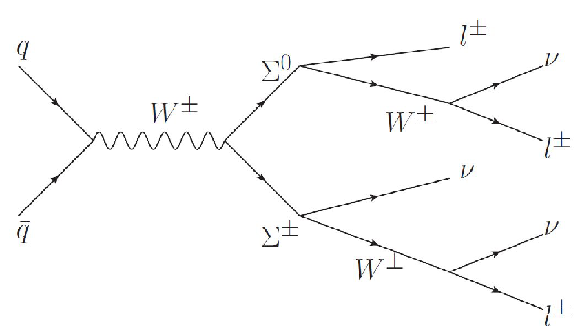
png pdf |
Figure 1-a:
One of the dominant Feynman diagrams for the production and decay of the neutral and charged heavy fermions: the $\Sigma ^0$ decays in $\mathrm{W}^{\pm }\ell^{\pm }$, the $\Sigma ^{\pm }$ decays into $\mathrm{Z}\ell^{\pm }$. |

png pdf |
Figure 1-b:
One of the dominant Feynman diagrams for the production and decay of the neutral and charged heavy fermions: the $\Sigma ^0$ decays in $\mathrm{W}^{\pm }\ell^{\pm }$, the $\Sigma ^{\pm }$ decays into $\mathrm{Z}\ell^{\pm }$. |
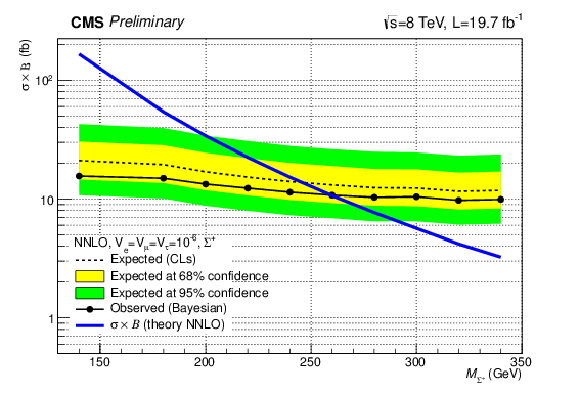
png pdf |
Figure 2-a:
The expected (dashed line) and observed (black points) exclusion limits at 95% confidence on $\sigma \times \mathcal {B}$ as a function of the $\Sigma ^+$ mass, $\Sigma ^-$ mass and for the combination of $\Sigma ^{+}$ and $\Sigma ^{-}$. The light (yellow) and dark (green) shaded areas represent the one standard deviation (68% CL) and two standard deviation (95% CL) limits, respectively, on the expected results (dashed line) obtained from MC pseudo experiments. These bands reflect the combined effect of statistical and systematic uncertainties. The black points are the observed results obtained from the data. The solid blue line corresponds to the seesaw triplet production cross section times the branching fraction $\mathcal {B}$ at NNLO. |
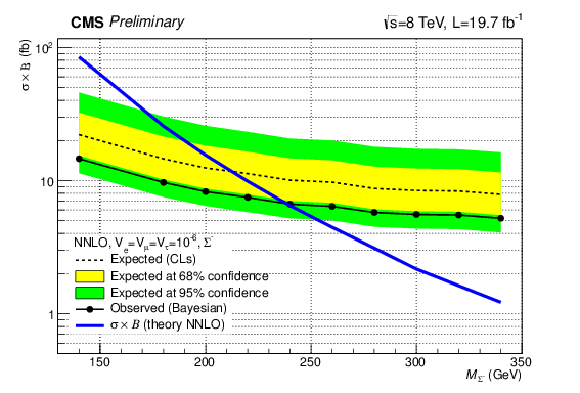
png pdf |
Figure 2-b:
The expected (dashed line) and observed (black points) exclusion limits at 95% confidence on $\sigma \times \mathcal {B}$ as a function of the $\Sigma ^+$ mass, $\Sigma ^-$ mass and for the combination of $\Sigma ^{+}$ and $\Sigma ^{-}$. The light (yellow) and dark (green) shaded areas represent the one standard deviation (68% CL) and two standard deviation (95% CL) limits, respectively, on the expected results (dashed line) obtained from MC pseudo experiments. These bands reflect the combined effect of statistical and systematic uncertainties. The black points are the observed results obtained from the data. The solid blue line corresponds to the seesaw triplet production cross section times the branching fraction $\mathcal {B}$ at NNLO. |
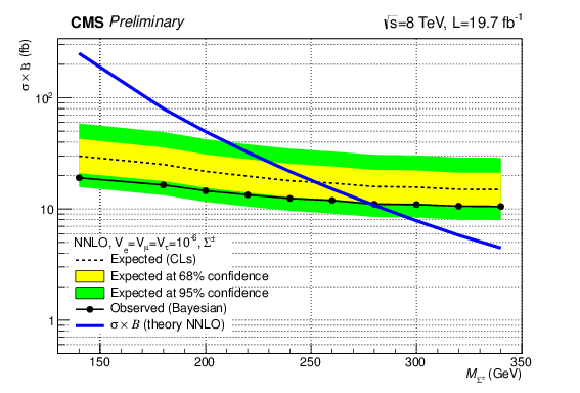
png pdf |
Figure 2-c:
The expected (dashed line) and observed (black points) exclusion limits at 95% confidence on $\sigma \times \mathcal {B}$ as a function of the $\Sigma ^+$ mass, $\Sigma ^-$ mass and for the combination of $\Sigma ^{+}$ and $\Sigma ^{-}$. The light (yellow) and dark (green) shaded areas represent the one standard deviation (68% CL) and two standard deviation (95% CL) limits, respectively, on the expected results (dashed line) obtained from MC pseudo experiments. These bands reflect the combined effect of statistical and systematic uncertainties. The black points are the observed results obtained from the data. The solid blue line corresponds to the seesaw triplet production cross section times the branching fraction $\mathcal {B}$ at NNLO. |

png pdf |
Figure 3-a:
Interpretation of the results: in the top figure are shown the bounds in the plane [$v_{\mathrm{e N}}, v_{\mathrm{\mu N}}$], in the bottom figure the same bounds in the plane [$v_{\mathrm{e N}}, v_{\mathrm{\tau N}}$]. The gray region is excluded by the unitarity requirement $v_{\mathrm{e N}}^2 + v_{\mathrm{\mu N}}^2 + v_{\mathrm{\tau N}}^2 = $ 1 . The solid black lines bound the scenarios with $v_{\mathrm{\tau N}}= $ 0 in the top figure and with $v_{\mathrm{\mu N}}= $ 0 in the bottom figure. The colored lines connect the scenarios with the same $M_{\Sigma ^{\pm }}$ limit, the values are derived from the measured limit in the flavor democratic scenario. Points on the plots are the mass limit for $\Sigma ^{\pm }$ in the flavor democratic scenario. |

png pdf |
Figure 3-b:
Interpretation of the results: in the top figure are shown the bounds in the plane [$v_{\mathrm{e N}}, v_{\mathrm{\mu N}}$], in the bottom figure the same bounds in the plane [$v_{\mathrm{e N}}, v_{\mathrm{\tau N}}$]. The gray region is excluded by the unitarity requirement $v_{\mathrm{e N}}^2 + v_{\mathrm{\mu N}}^2 + v_{\mathrm{\tau N}}^2 = $ 1 . The solid black lines bound the scenarios with $v_{\mathrm{\tau N}}= $ 0 in the top figure and with $v_{\mathrm{\mu N}}= $ 0 in the bottom figure. The colored lines connect the scenarios with the same $M_{\Sigma ^{\pm }}$ limit, the values are derived from the measured limit in the flavor democratic scenario. Points on the plots are the mass limit for $\Sigma ^{\pm }$ in the flavor democratic scenario. |
| Tables | |
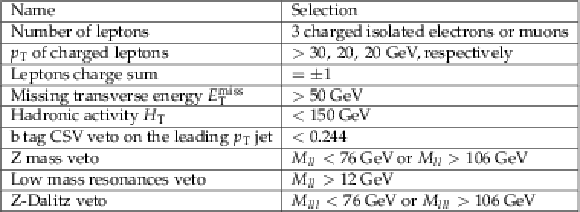
png pdf |
Table 1:
Criteria for the offline event selection. |
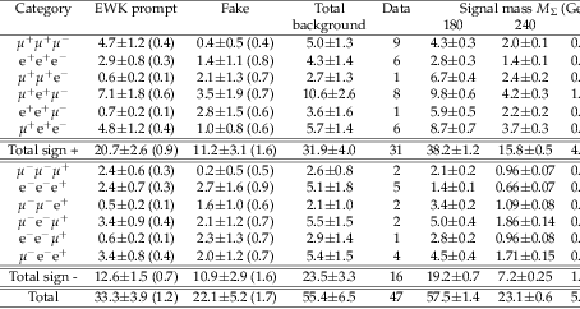
png pdf |
Table 2:
Predicted background yields with systematic uncertainties and observed data yields for all event categories. The values for three signal mass points are listed. For the EWK prompt and fake background sources, the statistical uncertainties are given in parenthesis. |
| Summary |
|
We performed a search for fermion triplet states ($\Sigma^{\pm} \Sigma^{0}$) predicted by the type III seesaw mechanism, a model proposed for the explanation of the neutrino masses. The analysis focuses on events with final states containing exactly three isolated leptons (muons or electrons) with the sum of the electric charges of $\pm$1, jets and an imbalance in transverse momentum. The dataset consists of proton-proton collisions at $\sqrt{s}= $ 8 TeV, recorded during 2012 by the CMS experiment at the CERN LHC, and corresponds to an integrated luminosity of 19.7 fb$^{-1}$. No evidence for pair production of $\Sigma^{\pm} \Sigma^{0}$ is found. Comparing the observed data with the predictions, we set upper limits at $95\,%$ confidence level on the production cross section of the fermion triplet pairs times the branching fraction to three-lepton final states. The observed upper bounds are: 19 fb for $\Sigma^{+}$, 8 fb for $\Sigma^{-}$, 12 fb for the combination of the two. Bounds are established on the mass ${M_\Sigma} $ of the $\Sigma$ states. The obtained lower limits are: 260 GeV for $\Sigma^{+}$, 238 GeV for $\Sigma^{-}$, and 278 GeV for the combination. This is a significant improvement with respect to the previous results obtained using the data taken by CMS in 2011, i.e. 179 GeV for $\Sigma^{+}$ [14]. For the first time limits are set on the negativley charged mediator and on the combination of the two. Previous limits are computed for the natural equal mixing angles between the fermion triplet and the leptons, i.e. $V_e = V_{\tau} = V_{\mu} = 10^{-6}$. An extension of the results is derived for a wider mixing parameter range. In this case, for triplets mixing with electrons and muons only, the bound on the $\Sigma^{\pm}$ mass is approximately 320 GeV. |

|
Compact Muon Solenoid LHC, CERN |

|

|

|

|

|

|